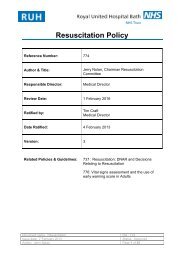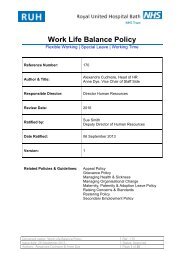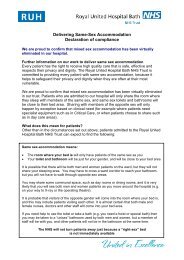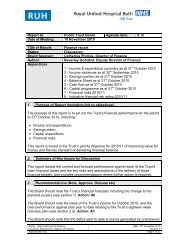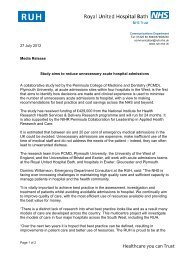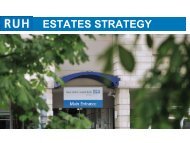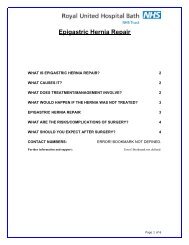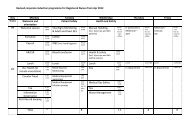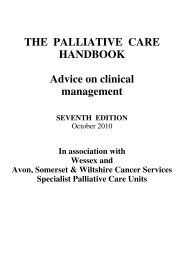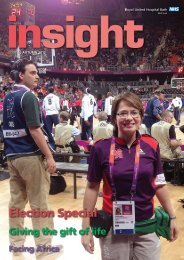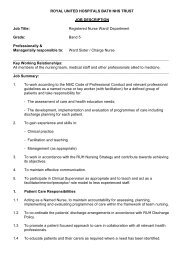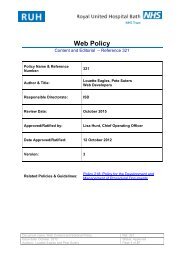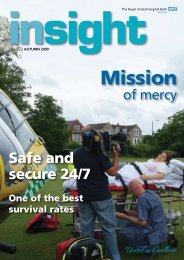Sharps & Contamination incident reporting procedure
Sharps & Contamination incident reporting procedure
Sharps & Contamination incident reporting procedure
Create successful ePaper yourself
Turn your PDF publications into a flip-book with our unique Google optimized e-Paper software.
Occupational Health Service<br />
based at the RUH Bath NHS Trust<br />
<strong>Sharps</strong> & <strong>Contamination</strong> <strong>incident</strong> <strong>reporting</strong> <strong>procedure</strong><br />
Procedure to be followed by staff following all sharps and contamination <strong>incident</strong>s.<br />
These are classified as <strong>incident</strong>s where you are exposed to blood, serum or other<br />
body fluid contaminated with blood. Incidents include:-<br />
• Percutaneous injuries such as needlestick injuries or sharps injuries. Bites (blood<br />
drawn)<br />
• Scratches (blood drawn)<br />
• <strong>Contamination</strong> of the mucous membrane (through the mouth & nose), or<br />
conjunctivae (through the eye)<br />
• Minor cuts, abrasions and other open skin lesions which become contaminated.<br />
Action to be taken following an <strong>incident</strong>:-<br />
1. Wash the site of exposure / injury liberally with soap and warm water but without<br />
scrubbing. Exposed mucous membranes or conjunctivae should be irrigated<br />
copiously with water. If there is a puncture wound free bleeding should be<br />
encouraged but the wound should not be sucked.<br />
2. Following a sharps or contamination <strong>incident</strong> the patient’s consent for testing must<br />
be obtained. If the patient is unconscious wait until they have regained full<br />
consciousness. It is illegal to test patients without consent in these circumstances<br />
and relatives cannot provide consent on their behalf. If appropriate, the injured<br />
person can take prophylactic treatment until consent has been obtained and the test<br />
result is known.<br />
3. Bleed the source patient (if known) for Hepatitis B & C and HIV as soon as possible<br />
(clotted yellow-topped bottle). The source patient should be provided with<br />
appropriate information about the implications of these tests and given appropriate<br />
time to consider and discuss them.<br />
A virology request form should be sent with the sample.<br />
4. Bleed the staff member involved in the <strong>incident</strong> for a 1 st storage sample (clotted<br />
yellow-topped bottle). Complete a virology request form.<br />
-
Reporting Procedure<br />
All <strong>incident</strong>s must be reported by telephone to the Occupational Health Department as<br />
soon as possible.<br />
• Call the RUH Occupational Health Department needlestick hotline Ext. 1001,<br />
externally 01225 821001 as soon as possible. The number is manned from 8.00 –<br />
17.00, Monday to Friday,<br />
• At all other times including bank holidays, the Occupational Health Department<br />
needlestick hotline provides an answerphone message giving instruction and advice<br />
and allows you to leave a message <strong>reporting</strong> the <strong>incident</strong>, which will ensure that the<br />
necessary follow up <strong>procedure</strong>s are implemented.<br />
• Complete a staff accident / <strong>incident</strong> report form and forward to the appropriate<br />
Department (RUH staff to send forms to Risk Management).<br />
Responsibility for <strong>reporting</strong><br />
The responsibility for compliance with these instructions lies with the injured employee<br />
and his/her immediate manager.<br />
The fact that the injured employee has been vaccinated against Hepatitis B does not<br />
preclude the need to bleed both the injured member of staff and the source patient or<br />
the necessity to follow the correct <strong>reporting</strong> <strong>procedure</strong>.<br />
Further advice<br />
If you need further advice out of hours for circumstances such as:<br />
• Assessment has identified a high risk of a communicable disease<br />
• Consent for testing cannot be obtained (patient refuses / unconscious etc.) the<br />
on-call virologist can be contacted (via switchboard - externally 01225 423881) for<br />
advice.<br />
HIV Post Exposure Prophylaxis (HIV PEP)<br />
If there is a concern about exposure to HIV during working hours telephone the<br />
needlestick hotline. Out of hours contact the RUH switchboard and ask for the doctor<br />
on call for HIV PEP.<br />
-



